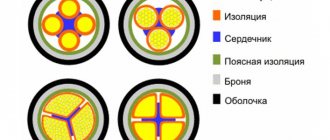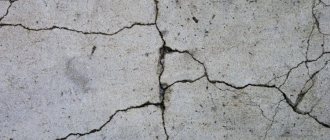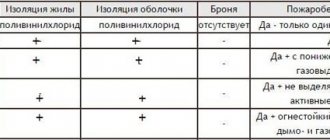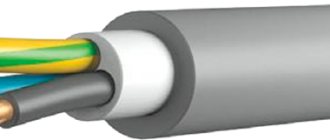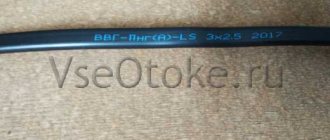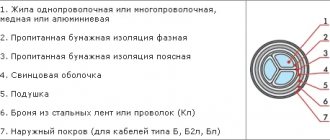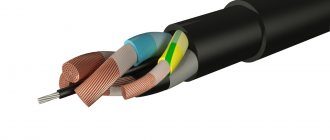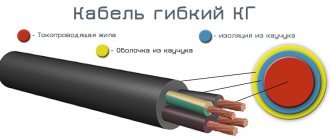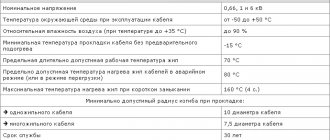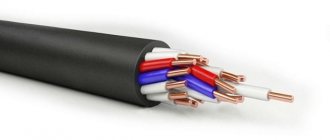The VVGng-LS cable allows you to transmit and distribute electrical energy in installations operating on direct current. One of the features of the VVGng-LS wire is its enhanced protection against fire processes.
The VVGng-LS cable is a conductor made of copper (multi-wire design, round). The insulating material has a reduced level of flammability. The insulating material consists of a polyvinyl chloride composition and has a low level of smoke and gas emissions. The VVGng-LS cable marking has the corresponding designations - LS. VVGng-LS has found its application during installation in various premises: industrial premises, special blocks and overpasses. The voltage class ranges from 660 to 1000 V. It has a high level of fire safety and non-flammability.
This cable is available in single or multi-wire versions. The shape of the veins is round or sector.
Decoding
Decoding VVGng-LS includes designations of core material. If there is no “A” designation, the wire is copper:
- B – designation of insulating material. The internal insulation is made of polyvinyl chloride.
- B – material of the outer shell. The material is similar to the main insulation.
- D – no protective coating (bare conductor).
- ng – does not support combustion processes.
- LS – literally “low smoke”. Low level of gas and smoke emission.
The “LS” designation is assigned to the cable only after successful testing. These test works are carried out in accordance with GOST R IEC 61034-1(2)-2005.
These tests are based on measurements of air transparency levels. Measurements are carried out in a special chamber before and after combustion. The devices record the level of light transmission, which decreases as smoke is released from the burning sample. The test result is an index in percentage equal to the ratio of light transmittance before and after testing. GOST R 53769-2010 defines a successful inspection with a transparency level of at least 40%. After which the conductor receives the corresponding designation in the marking.
Characteristics and meaning of the abbreviation VVGNG
Any cable of the VVGNG series, including a type such as LS, is a power cable , made of copper , and can have from one to three cores. Models with two cores are very common for wiring in houses or apartments. Also, the number of cable cores used directly affects its dimensions.
Any electrical product of the VVG series is equipped with a minimum residential cross-section of 1.5 square millimeters. But the cable itself can be large and have a much larger cross-section, in particular, up to 230 square millimeters. If the cable is equipped with two cores or more, then the number of its sections is 50 square millimeters maximum.
The size of the neutral core depends directly on the main current-carrying wires. For example, with a current-carrying core ranging in size from 1.5 to 2.5, the zero will have a cross-section of 1.5, respectively.
The abbreviation VVGNG stands for:
- B – vinyl shell;
- G – bare cable;
- NG is a non-flammable material.
Accordingly, the cable has a “bare” core, which is protected by double PVC insulation. There is no letter A in the name, therefore the wire is made of copper, as we have already mentioned. But let’s also find out what the last Latin letters LS mean in the name VVGNG LS, and also find out what other types of cable exist.
Application
The VVGng LS cable is used on direct or alternating current class 660, 1000 or 6000 V. It has increased fire resistance, and therefore is used in facilities with a low level of fire safety.
These conductors belong to classes P1.8.2.1.2 and P1.8.2.2.2. Used for laying in groups at residential and industrial sites. Also various cable structures, factories and industrial facilities. There is permission for operation at nuclear facilities.
The VVGng LS wire (especially if it is marked “LS”) is a universal conductor designed for various working conditions. Conductor Features:
- Can be used in rooms with high humidity.
- laying can be done at height. Therefore, it is used in underground networks and mines.
- in the presence of an open combustion source, it does not propagate combustion processes.
- technical characteristics of VVGng-LS allow operation in chemically aggressive environments: chemical and oil facilities.
- use at nuclear facilities of classes II-IV according to OPB-88/97.
- operation at different humidity levels.
- installation in air areas.
VVGng LS wire has become widespread when laid in dangerous sections of routes with a high level of combustion. The cable insulation is quite flexible and durable. One of the advantages of this brand is not only moisture resistance, but also resistance to chemically aggressive environments.
Cable shield
A special type of cable is shielded VVGE, used for transmitting audio and digital signals. Due to the fact that audio and digital signals travel through the cable, it is necessary to ensure that no distortion occurs. This requires a screen adaptation. To make a shielded wire, it is covered with a screen, that is, protection.
Screen types
- Screen made of copper or aluminum foil. It covers the cable around. But this method is fragile, so it is laid in stationary conditions.
- Shielded mesh shell. These products are highly reliable, but do not provide 100% coverage of the signal wire. Manufacturers can increase the density of shielded wire, but the cost will increase.
- Spiral braided wire. The cable is flexible and stronger than foil, but the coating does not achieve great results.
Weight depends on screen type.
Judging by the emerging shortcomings of each type of screen, a double shielded cable has appeared. This may be a combination of mesh and foil or two layers of spiral braids. Drain wire is added to strengthen the shielded cable.
An important technical characteristic of a shielded cable is the thickness of the foil. Manufacturers are constantly optimizing the manufacturing process, increasing the value to 100 microns. VVGng-LS manufacturers have taken care of a wide variety of cables that transmit electric current. They have different sections, lengths, and functionality.
Specifications
Operating temperature limit: t=±60?C; Operating voltage 660/1000 V; Relative humidity level (at t=35?C) ?=98%; Frequency – 50 Hz. Temperature of installation work without heating t?-15?C; Minimum bending radius during installation work: 7.5D for stranded wire, 10D for single-core wire (D-outer diameter); Operating operating temperature up to 70?C, in emergency situations up to 90?C, in short circuit mode up to 160?C, maximum long-term permissible temperature 400?C. Service period 30 years.
The outer diameter of the VVGng-LS cable differs depending on the nominal parameters.
Main criteria
The VVGNG copper cable has the following technical characteristics:
- Design. May have 1 to 5 cores. The first number in the abbreviation indicates how many there are. The veins can be round in shape or sectors. Cable VVGNG GOST 22483 can be single- or multi-wire of class 1 and 2. The color marking can be full color or just a strip that runs lengthwise and has a width of 1 mm. In the case of a multi-core cable, the cross-section of the pinching contact is allowed to be smaller than all others.
- Weight. The mass of one kilometer of cable can be in the range of 97-10526 kg, which is determined by the total cross-section.
- Cross section. This parameter shows the diameter of the cores from the outside. Can be in the range of 1.5-240 square millimeters. Thus, for sockets, a VVGNG copper cable of at least 2.5 mm2 is used, for lighting - at least 1.5 mm2, when connecting high-power equipment without a distribution box - at least 4 mm2.
Buy cable VVGng-LS
Our company is engaged in wholesale supplies of VVGng-LS power cables throughout Russia. Sales are subject to product availability or to order from manufacturers. You can leave your application in a way convenient for you (website, email). Our products have the required certificate for the VVGng-LS cable.
In the shortest possible time, technical specifications, possible discounts and terms of delivery of the product will be prepared.
The price of the VVGng-LS cable is determined individually based on the volume and conditions of the order. You can find out the final price and buy the VVGng-LS cable by leaving a request.
Design features
A description of the design of an electrical cable brand VVG NG ls is given by GOST 22483. It includes a single-, double- or multi-wire conductor made of copper. A polyvinyl chloride composition characterized by a low fire hazard coefficient is used as an insulating material.
VVGNG technical power cables are produced both round and flat. There can be a maximum of 5 current-carrying cores in a wire. They come in round and sector shapes. The cores are insulated with polyvinyl chloride in a distinctive color. So, for example, the core responsible for zero has a blue coating, and the grounding is covered with a PVC composition of a greenish-yellow color.
The conductors are class 1-2, twisted, the wire is filled with extruded PVC plastic, which has low smoke and gas emissions. In two- and three-core models, cores of the same cross-section are used; in four- and five-core wires, one core has a smaller size.
The thickness of the plastic compound must be at least 0.3 mm; the sector cores do not need to be filled with an inner sheath of plastic compound; it is enough to overlap them with polyethylene terephthalate film or thermally bonded fabric. The outer covering is made of PVC composition.
Benefits of modified insulation
VVG does not support combustion, if it is alone, when the cause of the fire is eliminated. In a group one, each smoldering shell heats up the adjacent hoses. The combustion will continue even after the root cause has been eliminated. To improve fire resistance, an additive is introduced and the marking is changed. The VVGng cable stops spreading flame when in a group.
Until the cause of the fire is eliminated, VVGng will continue to smolder, even without spreading combustion. High temperatures decompose plastic, releasing gases that are dangerous to people. Educational institutions, medical institutions, premises where people are, especially en masse, need to be installed with more modified materials. The VVGngls cable has additionally acquired the ability to reduce smoke formation and gas emission. The use of composites changed vinyl and made it possible to produce a model of reduced fire hazard, KVVG.
The introduction of modifiers, while slightly increasing the price, minimizes possible damage and makes it possible to prevent loss of life.
Storage and transportation rules
When moving the product, you must roll the drum carefully without throwing it. Otherwise, you can damage the wires and reduce the service life of the wire. There must be a special crane for moving and loading.
Proper storage in the warehouse
The product should only be stored in a dry room, away from heating devices or open sunlight. From time to time, check the integrity of the packaging, since warehouses are often inhabited by rodents that can damage the casing. Sometimes it is allowed to place cable drums under canopies in the open air. But such stay should not exceed 800 hours in total. There must be a box with sand in the room, which will be needed in case of fire.
You might be interested in: Features of heat shrink tube
Requirements for transportation of any cables:
- moisture, precipitation and sunlight should not enter the cargo compartment of the vehicle;
- Horizontal movement of the drum is not allowed so as not to damage the cable (except for air transportation);
- The cable drum must be secured in the cargo compartment so that it does not move around during transportation.
Note! The service life of cables depends on how correctly it was stored and transported.
Proper transportation of drums
